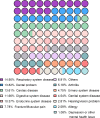Factors Associated with the Delay in Seeing a Doctor: Evidence of Chinese Middle-Aged and Older Adults
- PMID: 38164460
- PMCID: PMC10758318
- DOI: 10.2147/JMDH.S443683
Factors Associated with the Delay in Seeing a Doctor: Evidence of Chinese Middle-Aged and Older Adults
Abstract
Background: There have been few studies concerning delayed medical attention among middle-aged and older adults, and in-depth analyses of delay duration and symptoms have been lacking.
Methods: In this cross-sectional study exploiting a face-to-face questionnaire survey, we investigated delays in seeing a doctor among ≥ 45-year-old people in Zhejiang, China over the past year, and analyzed relevant influencing factors through logistics regression.
Results: A total of 1034 people aged ≥45 years were enrolled, whose overall occurrence of delay in seeing a doctor was 28.24% (23.00% for older adults aged ≥60 years). Factors like the presence of 2 chronic diseases, intense social loneliness, and more health care needs contributed to the occurrence of delay in seeing a doctor (OR (95% CI) = 2.102 (1.252-3.529); OR (95% CI) = 1.030 (1.002-1.059); OR (95% CI) = 1.049 (1.002-1.099). Contrastively, factors like convenient access to medical care and good self-reported health status inhibited such occurrence OR (95% CI) = 0.321 (0.199-0.519); OR (95% CI) = 0.369 (0.183-0.745). The foremost reason was wanting to wait and see if the problem would get better on its own (117, 40.07%). Respiratory system disease (14.90%), dental problems (13.82%), and cardiac disease (13.61%) constituted the top 3 types of diseases whose treatments were delayed. Additionally, for the majority of older adults, the delay duration was 1-2 weeks (99, 33.90%), and the economic burden was the cause of the longest delay in seeing a doctor among middle-aged and older adults.
Conclusion: To alleviate the problem of delay in seeing a doctor among middle-aged and older adults, their families and society should enhance care for them and reduce their sense of social loneliness. Emphasis should be placed by the government on helping middle-aged and older adults with financial difficulties so that their medical convenience can be improved.
Keywords: China; cross-sectional study; delaying doctor visits; middle-aged; older adults.
© 2023 Qin et al.
Conflict of interest statement
The authors declare that they have no competing interests.
Figures




Similar articles
-
Delay in seeing a doctor due to cost: disparity between older adults with and without disabilities in the United States.Health Serv Res. 2012 Apr;47(2):698-720. doi: 10.1111/j.1475-6773.2011.01346.x. Epub 2011 Nov 8. Health Serv Res. 2012. PMID: 22092264 Free PMC article.
-
The Association of Delayed Care With Depression Among US Middle-Aged and Older Adults During the COVID-19 Pandemic: Cross-sectional Analysis.JMIR Aging. 2021 Oct 5;4(4):e29953. doi: 10.2196/29953. JMIR Aging. 2021. PMID: 34524964 Free PMC article.
-
[Effect of Intergenerational Support from Children on Older Adults' Healthcare Seeking Behaviors].Sichuan Da Xue Xue Bao Yi Xue Ban. 2023 May;54(3):614-619. doi: 10.12182/20230560505. Sichuan Da Xue Xue Bao Yi Xue Ban. 2023. PMID: 37248593 Free PMC article. Chinese.
-
With free health services, why does the Brazilian working class delay in seeing the doctor?Trop Doct. 1989 Jul;19(3):120-3. doi: 10.1177/004947558901900309. Trop Doct. 1989. PMID: 2773050
-
Toward the realization of a better aged society: messages from gerontology and geriatrics.Geriatr Gerontol Int. 2012 Jan;12(1):16-22. doi: 10.1111/j.1447-0594.2011.00776.x. Geriatr Gerontol Int. 2012. PMID: 22188494 Review.
Cited by
-
Knowledge, Attitude and Practice Toward Intracerebral Hemorrhage Prevention Among Patients Taking Oral Anticoagulants.Int J Gen Med. 2024 Jul 16;17:3137-3146. doi: 10.2147/IJGM.S454039. eCollection 2024. Int J Gen Med. 2024. PMID: 39049832 Free PMC article.
References
-
- National Bureau of Statistics. Report of the seventh population census data in China. Available from: http://www.stats.gov.cn/tjsj/zxfb/202105/t20210510_1817176.html. Accessed February 20, 2023.
-
- World Bank. World bank report offers options for elderly care in China. Available from: https://www.worldbank.org/en/news/press-release/2018/12/13/world-bank-re.... Accessed March 16, 2023.
LinkOut - more resources
Full Text Sources
Miscellaneous

